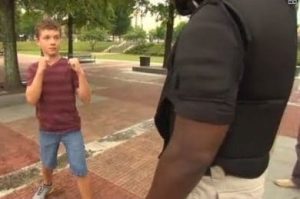My son recently took a self-defense class for kids. In classic fashion, he had a rollicking good time. But more importantly, he learned some practical techniques to fend off bullies and strangers. With regular practice via role-playing at home, we hope that he will be well prepared for the statistically-unlikely-yet-still-possible icky situation and will know exactly what to do to get out of it safely.

I just realized that I’ve written two posts within the last few weeks that allude to Stranger Danger. First was in my post about kids getting lost, and then again in my post about kids playing without adult supervision. Apparently, I’ve got it on the brain. In fact, I’ve been thinking about this very topic for a couple of years now, but I haven’t really broached the issue of strangers with my son until recently. I just thought he was too young before. I didn’t want to mar his innocence. I didn’t want to scare him too much or make him believe that the world was full of scary people wanting to snatch him up and take him away.
So I waited until now. I still wonder if it was a bit premature (he is almost 6), but I have no regrets about encouraging him to become more aware.
We took the class from an organization called Play It Safe (the homepage has a couple of great videos on teaching kids self defense against strangers and bullies). And no, I’m not getting any perks by blogging about it here. I’m sharing it simply because I was impressed by the class and the instructor. The class was at capacity with at least 20 kids present, and the ages ranged from about 5 to 10 years old. The instructor, Tracie Arlington, was engaging, clear, and motivating. The kids and parents really responded to her.
Here were our key takeaways from this program. Many of them can be used with both bullies and strangers, and can be employed by kids and adults alike.
Tips for Teaching Kids Self Defense
- Project confidence and power: Stand tall, hands to your sides or behind your back, feet apart, chin up.
- Defend yourself against physical aggression: Always keep 2 arm’s lengths between you and the bully. If they get too close, put your hands up by your face to protect your head and yell, “Back off! Leave me alone!”
- Know the difference between being a tattletale and reporting. You are not a tattletale if you are reporting an incident that could hurt someone.
- Know how to be a W.I.N.N.E.R. when dealing with a bully:
Walk away from the situation
Ignore the comment
Have No attitude or sassiness (Agree with the bully. Don’t say “whatever,” “who cares,” or “no”…these types of comments only anger bullies more.)
Say something Nice (“Hey, cool shirt!” Bullies have no idea how to deal with a compliment or smile!)
Escape. Refuse to fight. Turn and walk or run away to protect yourself.
Report the incident to an adult
- Use your biggest powers: Your loud voice, your strong legs, and your confidence
- Always keep strangers at least 5 arm’s lengths away. This includes strangers in cars.
- Always walk or jog with at least one buddy. And always walk or jog against traffic so that a) you can see if a car is following you and b) you can more easily run in the opposite direction.
- Never get in a car even if someone is pointing a gun at you. You have a 1% chance of coming home if you do.
- Never follow a stranger who asks for your help. Normal grownups never ask children for help. Only dangerous strangers do.
- Trust your gut. In other words, if you get a funny feeling around someone, that’s probably your “creep alarm” going off and it’s telling you to run away.
- Strangers are not always creepy looking. In fact, dangerous strangers can look nice and be well dressed and polite.
- When meeting someone new, shake hands (if you wish), and then take a step back. A creepy stranger will continue to come forward and invade your personal space.
- If grabbed, Play It Safe recommends going “Chihuahua Crazy!” Make tiger claws with your fingers and jab at the person’s eyes, then kick their shins, wiggle and squirm, do “windmills” with your arms, drop to the floor, kick, and scream, “Stranger! Stranger! 911!” If your feet are grabbed, do an “alligator roll” to break their hold and continue to kick. (There’s an excellent example of this on Play It Safe’s website.)
- Protect your body. If someone (even someone you know) tries to touch you inappropriately, yell, “Stop! Don’t touch me there! This is my No-No Square!”
- Parents/caregivers: If your child becomes lost, do not tell them to stay put because they may become a predator’s target. Instead, they should actively seek out help from a worker (or group of workers) or another mom with kids immediately. Teach them to approach someone who they see first (not someone who sees them first). And report a lost child immediately; do not waste valuable time going around in circles looking.
- Role-play, role-play, role-play.

Have you or has your child ever been bullied? Or been in a dangerous situation with a stranger? What happened? How did you or your child come out of it safely?


